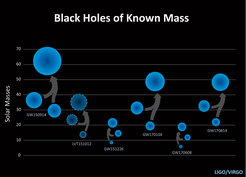LIGO instruments detect fifth binary black hole merger
New discovery is lightest system so far observed
On 8th June 2017, at 02:01 UTC, the two LIGO detectors have observed their fifth binary black hole merger gravitational-wave signal (named GW170608). The cosmic collision happened at a distance of roughly one billion light-years from Earth with component black holes of about 12 and 7 solar masses, respectively. This makes it the lightest black hole binary observed so far by the LIGO instruments. As before, scientists at the AEI in Potsdam and Hannover and at the Leibniz Universität Hannover have made crucial contributions in several key areas.
The LIGO Scientific and the Virgo collaborations announced the discovery in a paper, published on the arXiv e-print server today. The manuscript has been submitted to the science journal Astrophysical Journal Letters.
Being the lightest black hole binary so far, GW170608 hints at connections with other known astrophysical systems containing black holes, such as low-mass X-ray binaries. It also suggests that the black holes might have formed from a more recent (high-metallicity) generations of stars.
The astronomers find GW170608 to agree with predictions from Einstein's theory of general relativity. They also derived upper limits on the mass of the graviton, which are consistent with upper limits derived from previous observations.
The LIGO Scientific and the Virgo collaboration are currently preparing a full catalog of binary merger gravitational-wave events found in the second observation run “O2” that ended on 25th August 2017. The catalogue will include candidate signals with lower significance and systems other than stellar-mass black hole binaries.

LIGO and Virgo
LIGO is funded by the NSF, and operated by Caltech and MIT, which conceived of LIGO and led the Initial and Advanced LIGO projects. Financial support for the Advanced LIGO project was led by the NSF with Germany (Max Planck Society), the U.K. (Science and Technology Facilities Council) and Australia (Australian Research Council) making significant commitments and contributions to the project. More than 1,200 scientists and some 100 institutions from around the world participate in the effort through the LIGO Scientific Collaboration, which includes the GEO Collaboration and the Australian collaboration OzGrav. Additional partners are listed at http://ligo.org/partners.php.
The Virgo collaboration consists of more than 280 physicists and engineers belonging to 20 different European research groups: six from Centre National de la Recherche Scientifique (CNRS) in France; eight from the Istituto Nazionale di Fisica Nucleare (INFN) in Italy; two in the Netherlands with Nikhef; the MTA Wigner RCP in Hungary; the POLGRAW group in Poland; Spain with the University of Valencia; and the European Gravitational Observatory, EGO, the laboratory hosting the Virgo detector near Pisa in Italy, funded by CNRS, INFN, and Nikhef.












